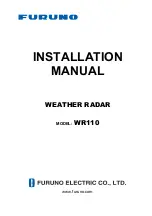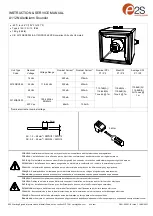
3
1. SYSTEM SUMMARY
RADAR (Radio Detection and Ranging) developed during World War II as a method to detect the presence of
ships and aircraft (the military considered weather targets as noise). Since WWII, there have been many
advances in radar technology (e.g., Doppler techniques). It is used on land, sea, and in space for both
research and operational needs.
1.1. Type of Radar Bands
There are several different categories according to the wavelength of using on radar in the world. Type
of bands are L, S, C, X, and K band.
L band radars:
“L” for “long”. This band is mostly used for clear air turbulence studies. It
operates on 15-30 cm wavelength and a frequency of 1-2 GHz.
S band radars:
“S” for “short”. It is not easily attenuated and is useful for near and long range
weather observation. It operates on 8-15 cm wavelength and a frequency of 2-4
GHz. Some weather services use it on a wavelength of just over 10 cm. The
drawback to this band of radar is that it requires a large antenna dish and large,
complex motors to power it. It is not uncommon for an S band dish to exceed
7.62 m in diameter.
C band radars:
“C” for “compromise”. The dish size does not need to as large so it is more
affordable for TV stations. It operates on 4-8 cm wavelength and a frequency of
4-8 GHz. It is best used for shorter range weather observation because the
signal is more easily attenuated by dry weather and rain. The frequency allows C
band radars to create a narrower beam width using a smaller dish. C band radars
also do not require as much power as S band radar.
X band radars:
“X” is derived from the XX2 secret band. It uses smaller wavelength, is more
sensitive and can detect smaller particles. It operates on 2.5-4 cm wavelength
and a frequency of 8-12 GHz. These radars are used for studies of cloud
development because they can detect the tiny water particles and also used to
detect light precipitation such as snow. X band radars also attenuate very easily
so they are used for only shorter range weather observation. Also due to the
small size of the radar it can easily transported, like the “Doppler on Wheels”
radar. Most commercial airplanes are equipped with X band radar to pick up
turbulence and other weather phenomenon.
K band radars:
“K” for “kurz (German for short). This band is split down the middle due to a
strong absorption line in water vapor and it is similar to the X band but is just
more sensitive. It operates on 0.75-1.2 cm or 1.7-2.5 cm wavelength and a
corresponding frequency of 27-40 GHz and 12-18 GHz.
Figure 1.1: Three general types of weather radar band
FURUNO
(φ1.08m)
Weather
Radar
X band
(φ3.3m)
Weather
Radar
Compact
Weather Radar
C band
(φ7.0m)
Weather
Radar
S band
(φ12.6m)
Weather
Radar
Large
Weather Radar
50m
Range
resolution
250m
1km
4km
60sec
80km
30sec
30km
Data
update
cycle
5min
250km
10min
450km
Detection
Range
-Prediction for short localized rainstorm
(Construction sites, man-navigation)
-Urban flood, sediment disaster monitoring
-Operational management of roads, railroads
-River flood, management of dams
High-precision monitoring of
precipitation intensity in local area
Application for meteorological disaster prevention
Weather forecast
(Movement of nimbus, precipitation)
Monitoring of typhoon, rain fronts
Difference between conventional weather radar and FURUNO
Summary of Contents for WR110
Page 1: ...INSTALLATION MANUAL WEATHER RADAR MODEL WR110 www furuno com...
Page 49: ...43 6 OUTLINE DRAWING 1 Antenna Unit...
Page 50: ...44 2 Junction Unit connection box...
Page 51: ...45 3 Junction Unit Wall mounted type...
Page 52: ...46 4 Data Processing Unit...








































